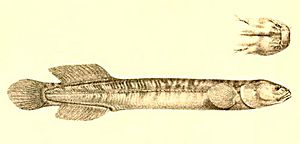Brown mudfish facts for kids
Quick facts for kids Brown mudfish |
|
|---|---|
 |
|
| Conservation status | |
| Scientific classification | |
| Genus: |
Neochanna
|
| Species: |
apoda
|
The brown mudfish (Neochanna apoda) is a special type of fish found only in New Zealand. It belongs to a family of fish called galaxiids. These fish live in wet areas like swamps and forests.
Brown mudfish usually grow to be about 10 to 13 centimeters long. They can live for at least 7 years. They are called "brown mudfish" because of their brownish color, which helps them blend in with their muddy homes.
Contents
What Does a Brown Mudfish Look Like?
Brown mudfish have unique fins. Their back fin (called the dorsal fin) and their belly fin (called the anal fin) are very long. They stretch almost all the way to their tail fin (the caudal fin), making them look nearly joined together.
Where Do Brown Mudfish Live?
These fish love to live in shallow, wet areas, especially in swampy forests. They are very good at surviving even when their home dries up.
Surviving Dry Times
If the water in their swamp dries out during summer, brown mudfish don't give up! They can go into a special sleep called aestivation. This means they hide in damp places, like under logs or in holes among tree roots. They stay there, waiting patiently, until the water comes back. It's like taking a long nap until conditions are good again.
Why Are Brown Mudfish Important?
Brown mudfish are an important part of New Zealand's unique wildlife. They help keep their wetland ecosystems healthy.
Conservation Status
Sadly, brown mudfish are facing challenges. In 2014, the New Zealand Department of Conservation said they were "At Risk: Declining." This means their numbers are going down. The IUCN, a big group that studies animals around the world, also listed the brown mudfish as "Endangered" in 2014. This means they are at high risk of disappearing if we don't protect them.
Protecting their wetland homes is very important to help these special fish survive and thrive for future generations.
See also
 In Spanish: Neochanna apoda para niños
In Spanish: Neochanna apoda para niños


